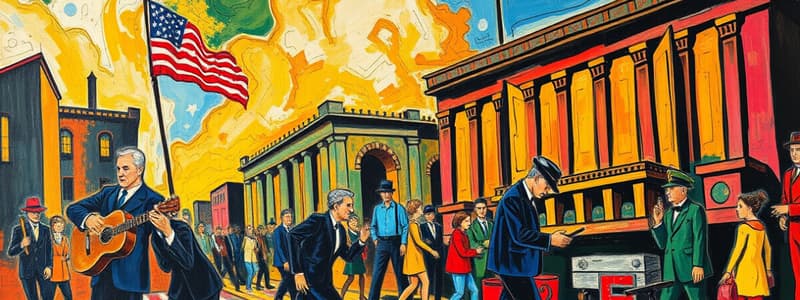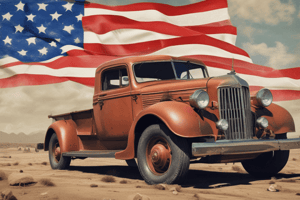Podcast
Questions and Answers
What started the Great Depression?
What started the Great Depression?
US stock market crash in 1929
What percent of Americans held 70 percent of America's wealth?
What percent of Americans held 70 percent of America's wealth?
1 percent
Wealthy investors and speculators took increasingly greater risks by buying ______.
Wealthy investors and speculators took increasingly greater risks by buying ______.
stocks
When prices fell, margin buyers started selling to pay their ______.
When prices fell, margin buyers started selling to pay their ______.
What led to a drastic decline in production?
What led to a drastic decline in production?
Who were the world's economic leaders who cut back lending?
Who were the world's economic leaders who cut back lending?
Who advocated a 'counter-cyclical policy' against depression?
Who advocated a 'counter-cyclical policy' against depression?
The 99 percent's halt in buying contributed to ______ cuts.
The 99 percent's halt in buying contributed to ______ cuts.
Where was the worst unemployment caused by the Great Depression?
Where was the worst unemployment caused by the Great Depression?
What was Franklin Delano Roosevelt's plan to reform capitalism called?
What was Franklin Delano Roosevelt's plan to reform capitalism called?
What was Roosevelt's basic goal during his presidency?
What was Roosevelt's basic goal during his presidency?
What marked a decisive turning point in the development of African nationalism?
What marked a decisive turning point in the development of African nationalism?
Who recovered more quickly from the Great Depression than any other major industrial power?
Who recovered more quickly from the Great Depression than any other major industrial power?
Totalitarianism is a form of government that exercises complete political power and control over all aspects of society.
Totalitarianism is a form of government that exercises complete political power and control over all aspects of society.
What did Stalin label as reactionary nationalists and enemies of socialism in Ukraine?
What did Stalin label as reactionary nationalists and enemies of socialism in Ukraine?
What have Stalin's and the Soviet government's policies been declared?
What have Stalin's and the Soviet government's policies been declared?
What was a terrible man-made famine in Ukraine in 1932 and 1933 that probably claimed 3 to 5 million lives?
What was a terrible man-made famine in Ukraine in 1932 and 1933 that probably claimed 3 to 5 million lives?
What side of the five-year plans was more successful?
What side of the five-year plans was more successful?
How were funds for industrial expansion collected from the people?
How were funds for industrial expansion collected from the people?
Who were hired to plan and construct many of the new factories?
Who were hired to plan and construct many of the new factories?
Taxes to pay for industrial investment reduced _____, so there was no improvement in the average living _____
Taxes to pay for industrial investment reduced _____, so there was no improvement in the average living _____
Who received old-age pensions, free medical services, and education?
Who received old-age pensions, free medical services, and education?
Stalin encouraged a return to _____ family values.
Stalin encouraged a return to _____ family values.
The push to build socialism culminated in ruthless _____ terror and a massive purging of the _____ party.
The push to build socialism culminated in ruthless _____ terror and a massive purging of the _____ party.
What was a serious problem as communists saw themselves as building the world's first _____ society?
What was a serious problem as communists saw themselves as building the world's first _____ society?
What was a particular problem that arose with housing?
What was a particular problem that arose with housing?
What was the tiny extremist group Hitler joined in Munich?
What was the tiny extremist group Hitler joined in Munich?
Who was the second president of the young democratic Germany?
Who was the second president of the young democratic Germany?
Hitler concluded that he had to gain power legally through what?
Hitler concluded that he had to gain power legally through what?
What act classified as Jewish anyone with 3 or more Jewish grandparents?
What act classified as Jewish anyone with 3 or more Jewish grandparents?
What reflected the individual's helplessness in a totalitarian state?
What reflected the individual's helplessness in a totalitarian state?
What did the Nazi Party launch to pull Germany out of the depression?
What did the Nazi Party launch to pull Germany out of the depression?
Who held on to most of their advantages during Nazi rule?
Who held on to most of their advantages during Nazi rule?
Who saw their organizations swallowed up in Nazi associations?
Who saw their organizations swallowed up in Nazi associations?
What was the next item in Hitler's agenda?
What was the next item in Hitler's agenda?
Flashcards are hidden until you start studying
Study Notes
Great Depression Origins and Causes
- The Great Depression was initiated by the US stock market crash in 1929.
- Wealth disparity: 1% of Americans owned 70% of the nation's wealth, forcing the majority to rely on borrowed money for basic purchases.
- Risky investment behaviors, particularly "buying on margin," where investors purchased stocks with minimal initial payment and borrowed the rest.
Economic Impact
- The decline in stock prices triggered a selling frenzy among margin buyers, creating a domino effect across global stock exchanges.
- The ensuing financial panic led to significant drops in production as countries enacted high protective tariffs.
- Many governments reduced spending and budgets, rather than increasing deficits to revitalize economies.
Social and Political Responses
- John Maynard Keynes promoted "counter-cyclical policy," advocating for government intervention to stimulate job growth and spending.
- The halt in consumer purchasing by the majority led to job cuts and increased unemployment, with the worst rates in the US.
- Support for ordinary individuals surged through the establishment of a national social security system and labor relations acts.
Global Context and Outcomes
- The Great Depression had devastating effects worldwide, particularly in Europe, with countries like Germany and Great Britain suffering heavily due to post-war debts.
- Scandinavian countries successfully navigated the crisis through social welfare benefits and public works projects.
- Latin America's reliance on limited agricultural exports left it vulnerable, prompting shifts toward economic nationalism.
Rise of Totalitarian Regimes
- The Great Depression contributed to the rise of radical dictatorships, like totalitarianism in the Soviet Union, Germany, and Italy.
- Totalitarian states characterized by propaganda, state-terror, and centralized economy emerged, with leaders like Stalin, Hitler, and Mussolini using the crisis to consolidate power.
- Fascist movements shared extreme nationalism and anti-communism, leading to alliances with powerful capitalists.
Soviet Economic Policies
- Stalin's Five-Year Plans aimed to modernize and industrialize the Soviet Union through collectivization, seizing agricultural land from peasants.
- The New Economic Policy (NEP) reintroduced limited market freedoms to boost the economy.
- Collectivization led to widespread famine in Ukraine, known as Holodomor, resulting in millions of deaths.
Effects on Society and Living Standards
- Rapid industrialization under state control led to urbanization but did not enhance living standards, contributing to scarcity of housing and resources.
- While offering some social benefits like pensions and medical services, the focus remained on collective advancement over individual welfare.### Soviet Workers and Stalin's Policies
- Soviet workers were specially skilled individuals crucial to the development of the Soviet Union under Stalin.
- Stalin emphasized a return to traditional family values, impacting women's roles and opportunities in work and education.
- Culture became heavily politicized through continued propaganda and indoctrination.
Terror and Purging in Stalin's Regime
- The push for building socialism was marked by ruthless police terror and extensive purging of the Communist Party.
- Gulags were notorious labor camps where escape was nearly impossible.
Stalin's New Generation of Communists
- Stalin recruited 1.5 million new party members to replace those purged, creating a cohort that effectively governed until the early 1980s.
- Collaborators facilitated Stalin's crime and achievement agendas.
Italy's Early 20th Century Liberal State
- Italy was a liberal state with civil rights, but widespread poverty and class differences existed.
- The parliamentary regime granted universal male suffrage, reflecting the nation's political changes.
Post-War Discontent in Italy
- The parliamentary government's modest territorial gains after World War I disappointed nationalists.
- Promises for social and land reform were unmet, causing unrest among workers and peasants.
Revolutionary Movements in Italy
- The Russian Revolution inspired a revolutionary socialist movement in Italy, prompting radical actions like factory occupations.
- By 1921, diverse groups, including socialists and conservatives, opposed the liberal parliamentary government.
Mussolini's Rise to Power
- Mussolini, initially a socialist leader, combined nationalist and socialist demands in his radical program.
- His program gained support by employing violent tactics against rival socialists.
Black Shirts' Role
- Mussolini's private army, known as the Black Shirts, violently targeted Socialist institutions and expelled Socialists from local governments.
Mussolini's Political Maneuvering
- Mussolini positioned himself as the savior and was appointed prime minister after marching on Rome with a fascist contingent.
- Press freedom was abolished, and Mussolini's government ruled by decree, arresting political opponents.
Mussolini's Ideology and Agreements
- Mussolini advocated for total state control with his slogan promoting the state's supremacy.
- The Lateran Agreement in 1929 recognized the Vatican's independence, securing papal support for the fascist regime.
Women's Roles under Fascism
- Mussolini's regime sought to return women to traditional roles, limiting their access to better-paying jobs to just 10%.
- Fascism did not lead to significant changes in women's rights.
Nature of Mussolini's Regime
- Racial laws were introduced only in 1938, with persecution of Jews escalating during World War II.
- Mussolini's state was not fully totalitarian, lacking comprehensive control over society.
Nazi Ideology and Hitler's Early Influence
- Nazism emerged from extreme nationalism and racism, with Hitler's beliefs rooted in Austrian nationalist ideologies.
- Hitler adopted anti-Semitism and Social Darwinism, seeing Jews as a threat to German culture.
Hitler's Political Ascendancy
- The Nazi Party, originally a small extremist group, gained popularity as Hitler promised economic recovery during the Great Depression.
- By 1932, the Nazis became the largest party in the Reichstag with 14.5 million votes.
Suppression of Opposition
- After becoming Chancellor, Hitler scapegoated the communist party for the Reichstag fire to consolidate power.
- The Enabling Act granted Hitler dictatorial powers, allowing him to outlaw opposition and suppress independent labor unions.
The Impact of Nazi Policies
- The Nazi government abolished all independent organizations, replacing them with a centralized party bureaucracy.
- Intellectual life became repressed, leading to a fearful, obedient society under Hitler's regime.
The Road to War
- Aggressive territorial aspirations and violations of treaties culminated in Germany’s rearmament and withdrawal from the League of Nations.
- British leaders, believing appeasement could prevent conflict, were criticized as neither prepared psychologically nor militarily for another war.
Formation of Axis Powers
- The Rome-Berlin Axis was established in October 1936, with Japan joining later, reflecting a geopolitical realignment in support of mutual interests.
Studying That Suits You
Use AI to generate personalized quizzes and flashcards to suit your learning preferences.




